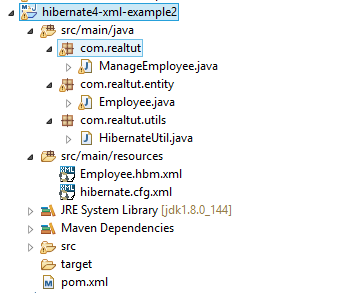This example apply following technologies:
- Eclipse Oxygen 4.7
- SQLServer 2017 Express
- JDK 1.8
- Hibernate 4.3.11.Final
Nội dung chính
Hibernate 4 XML Mapping Project Structure

Create Hibernate 4 XML Mapping - SQLServer 2017 Example
1. Create project "hibernate4-xml-example2"
You can refer to tutorial how to create maven project in Eclipse?.
Update pom.xml file:
<dependencies>
<dependency>
<groupId>org.hibernate</groupId>
<artifactId>hibernate-core</artifactId>
<version>4.3.11.Final</version>
</dependency>
<dependency>
<groupId>javassist</groupId>
<artifactId>javassist</artifactId>
<version>3.12.1.GA</version>
</dependency>
<dependency>
<groupId>com.microsoft.sqlserver</groupId>
<artifactId>mssql-jdbc</artifactId>
<version>6.1.0.jre8</version>
</dependency>
</dependencies>
2. Create table testdb.Employee
Use testdb; create table EMPLOYEE ( id INT NOT NULL IDENTITY(1,1), first_name VARCHAR(20) default NULL, last_name VARCHAR(20) default NULL, salary INT default NULL, PRIMARY KEY (id) );
3. Create entity class
Create Employee.java as a POJO class. It has properties, getters and setters for respective properties.
File: Employee.java
package com.realtut.entity;
public class Employee implements java.io.Serializable {
private Integer id;
private String firstName;
private String lastName;
private Integer salary;
public Employee() {
}
public Employee(String firstName, String lastName, Integer salary) {
this.firstName = firstName;
this.lastName = lastName;
this.salary = salary;
}
public Integer getId() {
return this.id;
}
public void setId(Integer id) {
this.id = id;
}
public String getFirstName() {
return this.firstName;
}
public void setFirstName(String firstName) {
this.firstName = firstName;
}
public String getLastName() {
return this.lastName;
}
public void setLastName(String lastName) {
this.lastName = lastName;
}
public Integer getSalary() {
return this.salary;
}
public void setSalary(Integer salary) {
this.salary = salary;
}
}
4. Create XML mapping file
Craete XML mapping file to map Java POJO class (com.realtut.entity.Employee) to database table (employee).
File: Employee.hbm.xml
<?xml version="1.0"?>
<!DOCTYPE hibernate-mapping PUBLIC
"-//Hibernate/Hibernate Mapping DTD 3.0//EN"
"http://www.hibernate.org/dtd/hibernate-mapping-3.0.dtd">
<hibernate-mapping>
<class name="com.realtut.entity.Employee" table="employee">
<id name="id" type="java.lang.Integer">
<column name="id" />
<generator class="identity" />
</id>
<property name="firstName" type="string">
<column name="first_name" length="20" />
</property>
<property name="lastName" type="string">
<column name="last_name" length="20" />
</property>
<property name="salary" type="java.lang.Integer">
<column name="salary" />
</property>
</class>
</hibernate-mapping>
5. Create hibernate configuration file
File: hibernate.cfg.xml
<?xml version="1.0" encoding="UTF-8"?>
<!DOCTYPE hibernate-configuration PUBLIC
"-//Hibernate/Hibernate Configuration DTD 3.0//EN"
"http://www.hibernate.org/dtd/hibernate-configuration-3.0.dtd">
<hibernate-configuration>
<session-factory>
<property name="hibernate.dialect">
org.hibernate.dialect.SQLServerDialect
</property>
<property name="hibernate.connection.driver_class">
com.microsoft.sqlserver.jdbc.SQLServerDriver
</property>
<property name="hibernate.connection.url">
jdbc:sqlserver://localhost:1433;databaseName=testdb;
</property>
<property name="hibernate.connection.username">
sa
</property>
<property name="hibernate.connection.password">
1234567890
</property>
<!-- List mapping XML files -->
<mapping resource="Employee.hbm.xml" />
</session-factory>
</hibernate-configuration>
6. Build SessionFactory object
File: HibernateUtil.java
package com.realtut.utils;
import org.hibernate.SessionFactory;
import org.hibernate.boot.registry.StandardServiceRegistry;
import org.hibernate.boot.registry.StandardServiceRegistryBuilder;
import org.hibernate.cfg.Configuration;
public class HibernateUtil {
public static SessionFactory getSessionFactory() {
SessionFactory sessionFactory = null;
try {
Configuration configuration = new Configuration();
configuration.configure();
StandardServiceRegistryBuilder builder
= new StandardServiceRegistryBuilder();
builder.applySettings(configuration.getProperties());
StandardServiceRegistry serviceRegistry = builder.build();
sessionFactory = configuration.buildSessionFactory(serviceRegistry);
} catch (Throwable ex) {
ex.printStackTrace();
}
return sessionFactory;
}
}
7. Create application class
Finally, we will create the application class to run by the main() method. There are some methods to perform CRUD operations (create, retrive, update, delete).
File: ManageEmployee.java
package com.realtut;
import java.util.Iterator;
import java.util.List;
import org.hibernate.HibernateException;
import org.hibernate.Session;
import org.hibernate.SessionFactory;
import org.hibernate.Transaction;
import com.realtut.entity.Employee;
import com.realtut.utils.HibernateUtil;
public class ManageEmployee {
private static SessionFactory factory;
public static void main(String[] args) {
// get session factory
factory = HibernateUtil.getSessionFactory();
// create manageEmployee object
ManageEmployee manageEmployee = new ManageEmployee();
// Add few employee records in database
Integer empID1 = manageEmployee.addEmployee("David", "Bishop", 1000);
Integer empID2 = manageEmployee.addEmployee("Chris", "Ali", 5000);
Integer empID3 = manageEmployee.addEmployee("John", "Vector", 10000);
// List down all the employees
System.out.println("List down all the employees:");
manageEmployee.listEmployees();
// Update employee's records
manageEmployee.updateEmployee(empID1, 5000);
// Delete an employee from the database
manageEmployee.deleteEmployee(empID2);
// List down new list of the employees
System.out.println("List down new list of the employees:");
manageEmployee.listEmployees();
}
// Method to CREATE an employee in the database
public Integer addEmployee(String fname, String lname, int salary) {
Session session = factory.openSession();
Transaction tx = null;
Integer employeeID = null;
try {
tx = session.beginTransaction();
Employee employee = new Employee(fname, lname, salary);
employeeID = (Integer) session.save(employee);
tx.commit();
} catch (HibernateException e) {
if (tx != null)
tx.rollback();
e.printStackTrace();
} finally {
session.close();
}
return employeeID;
}
// Method to READ all the employees
public void listEmployees() {
Session session = factory.openSession();
try {
List employees = session.createQuery("FROM Employee").list();
for (Iterator iterator = employees.iterator(); iterator.hasNext();) {
Employee employee = (Employee) iterator.next();
System.out.print("First Name: " + employee.getFirstName());
System.out.print(" Last Name: " + employee.getLastName());
System.out.println(" Salary: " + employee.getSalary());
}
} catch (HibernateException e) {
e.printStackTrace();
} finally {
session.close();
}
}
// Method to UPDATE salary for an employee
public void updateEmployee(Integer EmployeeID, int salary) {
Session session = factory.openSession();
Transaction tx = null;
try {
tx = session.beginTransaction();
Employee employee = (Employee) session.get(Employee.class, EmployeeID);
employee.setSalary(salary);
session.update(employee);
tx.commit();
} catch (HibernateException e) {
if (tx != null)
tx.rollback();
e.printStackTrace();
} finally {
session.close();
}
}
// Method to DELETE an employee from the records
public void deleteEmployee(Integer EmployeeID) {
Session session = factory.openSession();
Transaction tx = null;
try {
tx = session.beginTransaction();
Employee employee = (Employee) session.get(Employee.class, EmployeeID);
session.delete(employee);
tx.commit();
} catch (HibernateException e) {
if (tx != null)
tx.rollback();
e.printStackTrace();
} finally {
session.close();
}
}
}
Output:
List down all the employees: First Name: David Last Name: Bishop Salary: 1000 First Name: Chris Last Name: Ali Salary: 5000 First Name: John Last Name: Vector Salary: 10000 List down new list of the employees: First Name: David Last Name: Bishop Salary: 5000 First Name: John Last Name: Vector Salary: 10000
